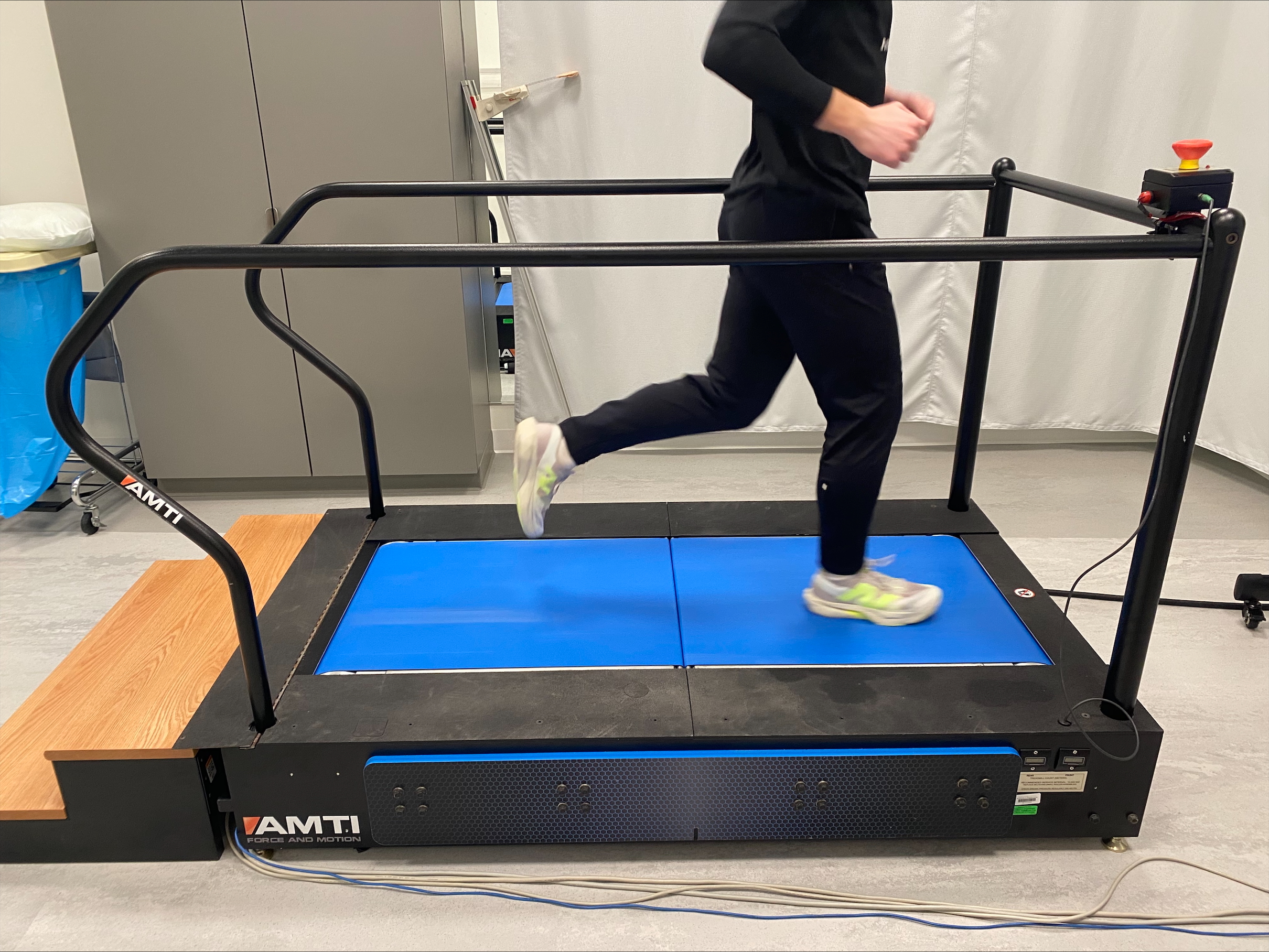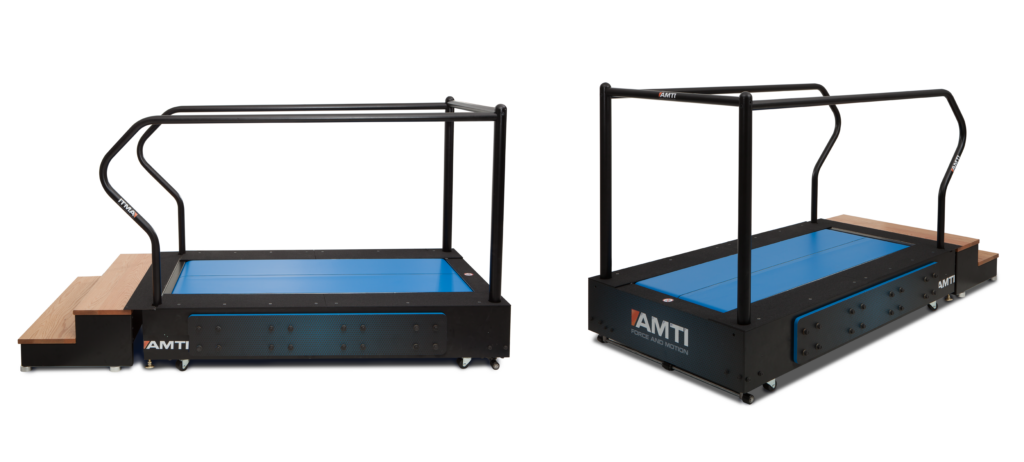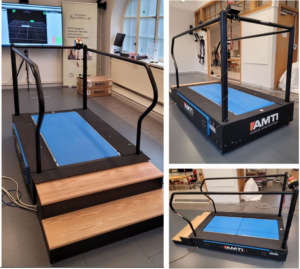Choosing the Right Treadmill for Your Research:
Tandem vs. Side-by-Side

Instrumented (force-sensing) treadmills are excellent solutions for recording long-duration, consecutive footfalls as an alternative to in-ground force plates. Large, in-ground force plate arrays can occupy a lot of valuable floor space and may require extensive motion capture systems to effectively measure their entire area. Instrumented treadmills, however, can provide equally effective foot strike data within a smaller, isolated capture volume, leaving the rest of your lab space available for other uses. Not only are they space-friendly solutions, but force-sensing treadmills ensure that a subject is providing quality data with every step by eliminating the need for re-do trials (when a subject’s foot fails to make full contact with the force plate). Instrumented treadmills also offer the unique advantage of collecting consecutive ground reaction forces while walking or running over long periods of time, providing better insight into more specific variables around gait adaptations and fatigue.
At AMTI we offer two models of advanced, split-belt instrumented treadmill systems: The Side-by-Side and The Tandem, each designed to support specific research applications. Both treadmills are built with AMTI multi-axis force plates embedded under each belt, ensuring precise and reliable data. However, their individualized belt configurations make them uniquely suitable for different subjects and types of research.
AMTI Side-by-Side Treadmill: Reliable Sagittal Analysis
The Side-by-Side Treadmill has a traditional design with two belts divided in parallel, isolating the left leg data to the left belt, and the right leg data to the right belt. Splitting the left and right treadmill belts in the sagittal plane is effective for analyzing typical walking and running movement patterns, in particular for patients or subjects who exhibit a shuffling gait or shortened stride length. This may include people with lower extremity prostheses, or those with neuromuscular disorders, such as cerebral palsy or multiple sclerosis.

The Side-by-Side split belt design also offers independent speed control for each belt, which is a popular feature for examining gait asymmetries. Often used for gait rehabilitation in stroke survivors, the ability to control separate belt speeds under each leg creates extensive research opportunities. This concept can be quite beneficial in both research and therapy settings, as it allows for tailored rehabilitation, addressing the specific needs of each leg, which may have varying levels of strength, coordination, or mobility after a stroke1.
AMTI Tandem Treadmill: Optimized for Natural Gait
AMTI’s patented Tandem Treadmill is unique in that the dual belts are split in a front-and-back configuration, as opposed to the well-known left-and-right design. The Tandem Treadmill is our most popular model for capturing natural walking and running gait for subjects of all ages. This belt design is exclusive to AMTI and allows for the collection of walking and running without worrying about mediolateral lower limb crossover between the two belts. It also eliminates the tendency for subjects to widen their stance and alter their gait, which can occur when using a side-by-side split belt treadmill2.

The tandem configuration optimizes all natural gait patterns by acting as one continuous surface. With this design, heel strike occurs on the front belt and the foot naturally translates to the rear belt for toe-off, all while measuring individual, bilateral ground reaction forces during both walking and running.
With this specialized tandem belt design, AMTI also offers our custom StrideWorks Software. StrideWorks automatically computes the segregated left/right leg 3D forces and moments in real time using the data collected from the front and back belts. This segregated data can then be streamed directly into any of the major motion capture systems via digital USB integration. See AMTI Partners for more information on compatible 3rd party systems.
The AMTI Advantage
Whether you’re considering the Side-by-Side or Tandem belt design for your research applications, both AMTI treadmills offer numerous, unique benefits for your lab space and data collection needs.
Compact Frame Allows for Easy Mobility and Visibility
Our treadmills are made with a high frequency frame and built-in standing feet, as they are designed to operate sitting directly on your lab floor without the need for any mounting or permanent installation. AMTI treadmills are also known for being fairly mobile compared to our competitors. Each treadmill ships on caster wheels, which make it easy to re-locate the treadmill to your lab space at delivery. The casters also offer the flexibility to move the treadmill around your lab space from time-to-time, if need be. Some of our customers with smaller labs utilize their space for many different applications and technology systems, and some even move the treadmill in/out of their capture volume on a daily basis.

The treadmills’ compact size also makes them minimally invasive, letting you easily position them anywhere within your motion capture volume. Furthermore, both of our treadmills are built with a low deck height, allowing you to use them at maximum incline without worrying about marker or camera obstructions with your motion capture system, which can happen with other, larger instrumented treadmills.
Other Key Features:
In addition to these perks, other key features of AMTI instrumented treadmills include:
- Inclination up to 25% grade (14 deg)
- Bidirectional belts
- Removable side handrails
- Ships fully assembled with all software preloaded on AMTI-supplied PC
- Digital and analog outputs (Digital USB integration with all major motion capture systems)
- Optional installation (“Above-Ground” or “In-Ground” mounted in floor recess)
Have questions about our Instrumented Treadmills? Contact us today!
References
- Dzewaltowski, A. C., Hedrick, E. A., Leutzinger, T. J., Remski, L. E., & Rosen, A. B. (2021). The effect of split-belt treadmill interventions on step length asymmetry in individuals poststroke: A systematic review with meta-analysis. Neurorehabilitation and Neural Repair, 35(7), 563–575.
https://doi.org/10.1177/15459683211011226 - Altman, A. R., Bastian, A. J., & Melendez, D. (2012). Kinematic comparison of split-belt and single-belt treadmill walking and the effects of accommodation. Gait & Posture, 35(4), 674–679.
https://doi.org/10.1016/j.gaitpost.2011.12.021
